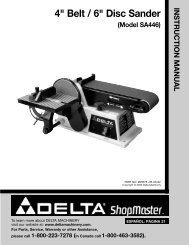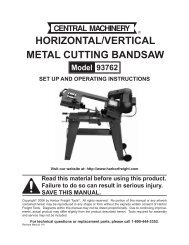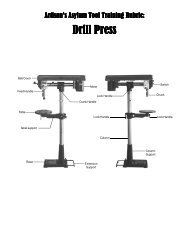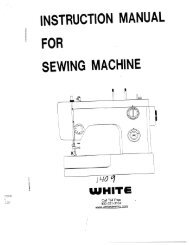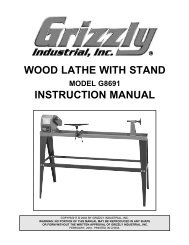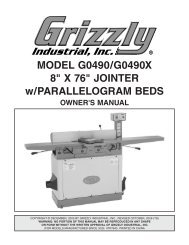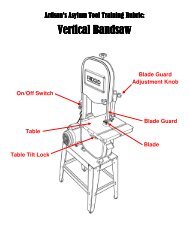Create successful ePaper yourself
Turn your PDF publications into a flip-book with our unique Google optimized e-Paper software.
ELECTRICAL<br />
EXTENSION CORDS<br />
Use only 3-wire extension cords that have 3-prong grounding<br />
plugs and 3-pole receptacles that accept the tool's plug.<br />
When using a power tool at a considerable distance from the<br />
power source, use an extension cord heavy enough to carry<br />
the current that the tool will draw. An undersized extension<br />
cord will cause a drop in line voltage, resulting in a loss of<br />
power and causing the motor to overheat. Use the chart<br />
provided below to determine the minimum wire size required<br />
in an extension cord. Only round jacketed cords listed by<br />
Underwriter's Laboratories (UL) should be used.<br />
**Ampere rating (on tool faceplate)<br />
0-2.0 2.1-3.4 3.5-5.0 5.1-7.0 7.1-12.0 12.1-16.0<br />
Cord Length Wire Size (A.W.G.)<br />
25' 16 16 16 16 14 14<br />
50' 16 16 16 14 14 12<br />
100' 16 16 14 12 10 —<br />
**Used on 12 gauge - 20 amp circuit.<br />
NOTE: AWG = American Wire Gauge<br />
When working with the tool outdoors, use an extension cord<br />
that is designed for outside use. This is indicated by the<br />
letters "WA" on the cord's jacket.<br />
Before using an extension cord, inspect it for loose or<br />
exposed wires and cut or worn insulation.<br />
WARNING:<br />
Keep the extension cord clear of the working area.<br />
Position the cord so that it will not get caught on<br />
lumber, tools or other obstructions while you are<br />
working with a power tool. Failure to do so can<br />
result in serious personal injury.<br />
SPEED AND WIRING<br />
The no-load speed of this tool is approximately 3000 fpm.<br />
This speed is not constant and decreases under a load or<br />
with lower voltage. For voltage, the wiring in a shop is as<br />
important as the motor’s horsepower rating. A line intended<br />
only for lights cannot properly carry a power tool motor. Wire<br />
that is heavy enough for a short distance will be too light for<br />
a greater distance. A line that can support one power tool<br />
may not be able to support two or three tools.<br />
GROUNDING INSTRUCTIONS<br />
In the event of a malfunction or breakdown, grounding<br />
provides a path of least resistance for electric current to<br />
reduce the risk of electric shock. This tool is equipped<br />
with an electric cord having an equipment-grounding<br />
conductor and a grounding plug. The plug must be plugged<br />
into a matching outlet that is properly installed and grounded<br />
in accordance with all local codes and ordinances.<br />
Do not modify the plug provided. If it will not fit the outlet,<br />
have the proper outlet installed by a qualified electrician.<br />
Improper connection of the equipment-grounding conductor<br />
can result in a risk of electric shock. The conductor with<br />
insulation having an outer surface that is green with or without<br />
yellow stripes is the equipment-grounding conductor. If<br />
repair or replacement of the electric cord or plug is necessary,<br />
do not connect the equipment-grounding conductor<br />
to a live terminal.<br />
Check with a qualified electrician or service personnel if the<br />
grounding instructions are not completely understood, or if<br />
in doubt as to whether the tool is properly grounded.<br />
Repair or replace a damaged or worn cord immediately.<br />
This tool is intended for use on a circuit that has an outlet<br />
like the one shown in figure 1. It also has a grounding pin<br />
like the one shown.<br />
WARNING:<br />
Check extension cords before each use. If<br />
damaged replace immediately. Never use<br />
tool with a damaged cord since touching the<br />
damaged area could cause electrical shock<br />
resulting in serious injury.<br />
ELECTRICAL CONNECTION<br />
This tool is powered by a precision built electric motor. It<br />
should be connected to a power supply that is 120 volts,<br />
60 Hz, AC only (normal household current). Do not operate<br />
this tool on direct current (DC). A substantial voltage drop<br />
will cause a loss of power and the motor will overheat. If the<br />
saw does not operate when plugged into an outlet, double<br />
check the power supply.<br />
GROUNDING<br />
PIN<br />
COVER OF GROUNDED<br />
OUTLET BOX<br />
Fig. 1<br />
8



